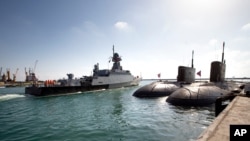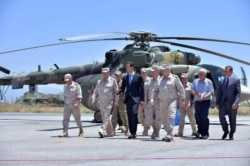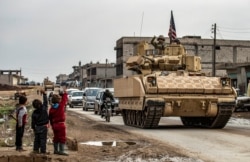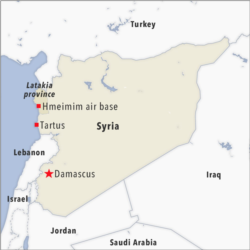Russia is expanding its navy base at the Syrian port of Tartus and planning to construct a floating dock to boost the port’s ship repair facilities, according to Russian military officials.
The move comes only weeks after the Russian military extended one of the runways at its Hmeimim airbase, adding to its military foothold in the eastern Mediterranean. The floating dock is scheduled to be completed next year, says Russia’s TASS news agency, quoting military officials.
Upgrading the repair facilities at the Tartus base will allow the Russian navy to avoid dispatching ships to naval installations in the Black Sea for maintenance, according to Western military officials. The Russian naval facility in Tartus is leased from the Syrian government of Bashar al-Assad, and four years ago the Russian military classified it as a Material-Technical Support Point and not formally as a base.
That changed in 2017 following a deal struck by Syria with Moscow, which has been waging a military campaign in Syria in support of Assad, allowing him to reclaim control from rebels over much of the country. The deal allows Russia use of the naval facility free of charge for 49 years and gives the Kremlin sovereign jurisdiction over the base. The agreement also allows Russia to keep a dozen warships — including nuclear-powered vessels — at Tartus, the only navy facility the Kremlin possesses outside the former Soviet Union.
Tartus and the Hmeimim air base, in the nearby province of Latakia, have been the main hubs for Russia’s pro-Assad military intervention. A Russian military spokesman told reporters Wednesday during a Moscow news briefing that Russian warplanes flying out of the Hmeimim base assisted Syrian government forces to kill 338 “terrorists” since April 23.
“Units of Syria’s pro-government troops, with the support of the Aerospace Forces of Russia, continue their search and reconnaissance missions in the Syrian desert. Since April 23, a total of 228 members of terrorist groups have been killed and 44 captured, 20 vehicles have been seized and six destroyed, 38 facilities and 45 hideouts have been demolished,” the spokesperson said.
Since 2015, Russia has pursued an increasingly forward-leaning role in the Middle East “with the shift to military intervention in the Syrian Civil War marking a notable turning point,” according to Diana Galeeva, an academic at Oxford University’s St. Antony’s College.
Russia has justified its presence in Syria by saying it is fighting Islamic State and other extremist groups, Galeeva says in a paper published by the Middle East Institute, a U.S.-based research group. But geopolitically, “Syria has been crucial to the return of Russia’s great power status, at least on the basis of military power influence” in the region, including in the eastern Mediterranean.
U.S. Middle East policy
The Biden administration has indicated it is ready to re-engage in the Middle East, repair multilateral coalitions and reassert its leadership role in the region. In February the U.S. carried out an airstrike targeting Iran-backed militias in Syria, the first military action undertaken by the Biden administration.
The Pentagon said the strike was ordered in response to attacks against U.S. and coalition personnel in Iraq and was a “proportionate military response” taken after consulting Western coalition partners.
But Biden officials have been in no rush to offer a clear definition of America’s role in Syria’s ongoing conflict that involves a half-dozen state and non-state militaries — including U.S. troops aligned with Syria’s Kurds.
Officials tell VOA they are shaping policy to try to balance U.S. President Joe Biden’s determination to end American participation in “forever wars,” while ensuring the United States doesn’t weaken its leadership in the region and inadvertently boost the regional influence of Russia and other rivals, including Iran.
An early Syria test for the Biden administration is likely in July over the delivery of United Nations aid to millions of Syrians sheltering in the northwest province of Idlib, which is not controlled by the Syrian government, The Wall Street Journal reported this week.
Russia has threatened to block international aid flowing into Idlib via the border crossing between Syria and Turkey at Bab al-Hawa, saying all aid should be distributed from areas controlled by the Assad government. The U.N. also has been using the border crossing to launch a coronavirus vaccination campaign in northern Syria.
Last week, the White House called on “the Assad regime and its backers to stop its violent war against its own people, enact a nationwide cease-fire, enable the unobstructed delivery of humanitarian assistance to all Syrians in need, and to negotiate a political settlement in Syria.” Biden also extended for another year sanctions imposed on the Assad government for rights violations and the use of chemical weapons.











